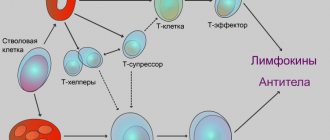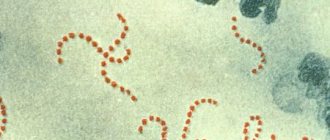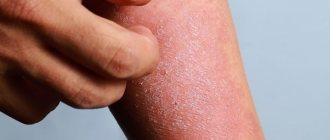Allergies in children are as common as colds. While many parents may find it intuitive to distinguish between runny nose symptoms and allergies, in some cases it can be quite challenging, especially if symptoms appear when plants are in bloom.
If persistent symptoms of a runny nose, cough, sneezing and itchy eyes persist for more than a week while pollen is flying, then an allergy is most likely to blame for your runny nose. But with one important caveat - if your child is an infant or a toddler under the age of three, then he is much less likely to have seasonal allergies. While there are exceptions to every rule, most children don't begin to experience hay fever symptoms until they are 3 or 4 years old, after they have been seasonally exposed to large amounts of pollen and have developed a sensitivity to the allergen. Interestingly, pollen allergies and food allergies are linked: more than half of children who suffer from hay fever also have food allergies.
How do allergies occur in children?
Allergy symptoms occur when a child's body overreacts with a protective immune response to normally harmless substances. Instead of not reacting to dandelion, an allergic child's body will quickly release a series of chemicals (including histamines) upon encountering the flower that cause itchy and red eyes, swollen mucous membranes, a runny nose and sometimes a cough. There is no clear, accurate way to tell at a glance whether your child has seasonal allergies when they start sneezing in the spring (or fall).
What to do if an allergic rash appears in a newborn?
- Consult your pediatrician to determine the cause of the rash. Never give medications or antibiotics without a doctor's prescription.
- Do not overdry the baby's skin. Treat the rash areas with a non-greasy hypoallergenic cream. Pharmacy cream "La-Cri" is a natural cosmetics that does not contain hormonal components, dyes or fragrances. The cream perfectly removes peeling and redness, promotes healing and relieves itching, including on the legs. It is important that La-Cri products are approved for use by infants - this is confirmed by a state certificate and numerous studies. The brand's medicinal cosmetics are sold only in pharmacies, which is also a sign of the quality of the product.
What is hay fever and why does it occur?
Hay fever is the most common type of allergy and is an allergic reaction to pollen in the air and environment. Children with seasonal allergies exhibit symptoms at certain times of the year when certain allergy triggers (such as grass or tree pollen) are circulating. However, some children and adults may be allergic to more than one pollen or trigger, causing symptoms to appear at different times throughout the year. Most children with hay fever experience a noticeable change in symptoms around the same time each year, which is during the flowering season.
Seasonal allergies typically first appear after preschool age, although they can develop at any time during childhood, usually before age 10. Allergy symptoms typically change with age, peaking in your 20s, and then often disappear as you get older. Allergies are usually inherited. If one parent has allergies, there is a 25% chance that the child will also have allergies. And if a child is lucky enough to have both parents with allergies, the risk of developing allergies increases to more than 60%.
- Gallery
- Reviews
- Articles
- Licenses
- Vacancies
- Insurance partners
- Partners
- Controlling organizations
- Schedule for receiving citizens for personal requests
- Online consultation with a doctor
- Documentation
Allergy - what is it?
Allergy is a special state of immunity, characterized by an altered response of the body to antigens (from the Greek Allos - other + Ergon - action).
Antigens are substances that, when entering the body, can cause an immune response. In response to the entry of antigens (viruses, bacteria) into the body, special types of substances are formed - antibodies. The job of antibodies is to help cells of the immune system neutralize substances that invade the body - antigens, such as bacteria and viruses.
But sometimes the immune system begins to react to completely harmless substances (allergens) as if they were dangerous antigens, so antibodies are formed to them and active substances (mediators) are released that cause various manifestations of allergies.
At the same time, the formation of mediators, the action of which is aimed at fighting bacteria and viruses, is suppressed. This explains why children with allergies often suffer from ARVI, and proves the need, first of all, for proper treatment of an allergic disease, and not the prescription of immunostimulating drugs.
Why do some people have allergies and others not?
Allergies are genetically determined diseases, i.e. The predisposition to developing allergies is inherited. So, if one of the parents suffers from allergies, the probability of an allergic disease in the child ranges from 25 to 40%. If both parents suffer from allergies, the probability increases to 50–75%. But the probability may be realized, or it may not. This depends on a number of other factors that contribute to the appearance of allergies, these include: the level of antigenic load (living conditions, unhealthy diet), ecology, etc.
Unfortunately, or maybe this will reassure you, today every fifth person suffers from allergies, and according to some data, every third person. At the same time, in recent decades there has been a steady increase in the prevalence of allergic diseases.
How does an allergy manifest itself?
Allergy is a disease that can affect various organs and systems. Most often the skin, respiratory (bronchial tubes, nasopharynx) and gastrointestinal tracts are affected.
The most common manifestations of allergies
| Organ affected | Diseases |
| Skin covering | Urticaria, Quincke's edema, atopic dermatitis |
| Respiratory tract | Allergic rhinitis, allergic bronchitis, bronchial asthma |
| Gastrointestinal tract | Oral allergy syndrome, enterocolitis, proctitis, food protein-induced enteropathy, eosinophilic esophagitis, gastroenteritis |
| System | Anaphylaxis |
What causes allergies?
In young children, food allergens are the leading factors in the development of allergic diseases. The high incidence of food allergies in young children is explained by the immaturity of the immune and enzyme systems of the gastrointestinal tract. As a result, food may not be broken down into non-allergenic components, which contributes to the development of an allergic reaction. Any food product can be an allergen, but some (cow's milk, eggs, citrus fruits, chocolate, fish, poultry) are much more likely to cause allergies than others.
At the same time, it should be noted that even in young children, the cause of allergic diseases can also be household allergens - house dust mites, animal allergens (especially cats). After 3 years of age, the importance of food sensitization decreases, and the role of inhalation allergens (dust, pet hair, aquarium fish food, bird feathers, detergents, house dust mites, mold spores, etc.) increases.
How to determine the significance of an allergen in the development of a disease?
An allergist will help you identify these allergens, although this is a very difficult task.
At the first stage, the allergist tries to identify (during a conversation with you)
- the nature of the symptoms (runny nose, cough, rashes, etc.);
- connection between the occurrence of symptoms and allergen exposure (plant flowering, cleaning, product consumption, etc.);
- the time period required for symptoms to appear;
- sequence of symptoms, their duration, etc.
All this information can help determine the significance of the allergen in the development of the disease, and even suggest the mechanism of development of the allergic reaction.
If necessary, the doctor may recommend an allergy examination: determining the level of specific immunoglobulins E (IgE) in the blood serum and/or performing skin prick tests.
What are elimination measures and why are they needed?
Elimination measures are aimed at eliminating the effects of the allergen, since the most important thing in the treatment of any allergic disease is to remove (eliminate) the allergens that cause the disease!
In case of food allergies , it is necessary to exclude the product that causes the allergy. An allergist will help you identify the cause-significant product. This can be either one product or a whole group. As already mentioned, the most common causes of allergic diseases in children are: cow's milk, eggs, fish, wheat, nuts, peanuts. Sometimes allergies can be caused by foods that are harmless in the generally accepted sense: potatoes, cabbage, apples, etc.
It is also necessary to take into account that there is a group of foods called triggers or provocateurs, which can cause an exacerbation of allergies. These include: shelf-stable products containing dyes, spices, preservatives, stabilizers, food additives marked on the packaging with the letter “E”, canned foods, meat broths, chocolate, cocoa, red and orange vegetables and fruits, fish, seafood, tomatoes, mushrooms, honey, nuts, sauerkraut, sausages, pork liver, spinach.
Products high in tyramine: cheeses (Roquefort, Camembert, Brie, Grillard, Cheddar, processed), brewer's yeast, pickled herring, avocado. There is a particularly high content of food additives in multi-colored candies, chips, crackers, carbonated drinks, etc. However, as a rule, this reaction cannot be confirmed by an allergological examination, but only by observing the child.
Hypoallergenic (without specifying a specific allergen) is a diet that excludes from the child’s diet, first of all, these foods that may cause an exacerbation of allergies.
All patients with allergic diseases must carry out elimination measures aimed at reducing the concentration of household, epidermal and fungal allergens in the apartment where the child lives.
For this it is recommended: replacing woolen, down blankets and pillows with synthetic ones, cotton wool; remove carpets, do not have animals, glass books, reduce their number, use modern vacuum cleaners to clean rooms (in the absence of a child), purchase air purifiers. In addition, daily wet cleaning of the apartment is mandatory. These measures make it possible to maintain a hypoallergenic regime in the home, which sharply reduces the allergenic load on the child’s fragile immune system.
What is the treatment for allergic diseases?
Treatment of allergic diseases is based on compliance with two basic principles:
- Eliminating contact with the allergen (elimination)
- Pharmacotherapy
Only a doctor should prescribe pharmacotherapy to a patient with an allergic disease, since the prescription of certain drugs for each specific patient must be strictly individual, taking into account the age of the child, the nature, severity and stage of the disease, and associated complications. In addition, constant monitoring of the dynamics of the disease with timely replacement of the drug is necessary.
Make an appointment with a pediatric allergist-immunologist by calling +7(495)150-60-03
Services and prices
Primary appointment (examination, consultation) with an allergist-immunologist
2,200 rub.
Repeated appointment (examination, consultation) with an allergist-immunologist
2,100 rub.
Preventive appointment (examination, consultation) with an allergist-immunologist
2,000 rub.
Carrying out skin prick tests (with 1 allergen)
500 rub.
Carrying out skin prick tests (up to 10 allergens)
2,200 rub.
Carrying out skin prick tests (more than 10 allergens)
3,100 rub.
Appointment with an allergist-immunologist for allergen-specific immunotherapy (ASIT) without the cost of the drug
2,000 rub.
Follow-up examination by an allergist-immunologist (in the first 10 days from the date of treatment)
610 rub.
Preventive appointment (examination, consultation) with an allergist-immunologist before vaccination
2,000 rub.
Pediatric panel No. 1 (IgE) (8 allergens) (cow's milk protein, wheat, oats, chicken egg white, beef, turkey, apple, broccoli) blood (serum)
RUB 1,980
Pediatric panel No. 2 (IgE) (8 allergens) (cod, chicken, zucchini, cauliflower, potatoes, carrots, banana, orange) blood (serum)
RUB 1,980
Panel grass and trees No. 1 (8 allergens) (birch, hazel, alder, timothy, cocksfoot, fescue, wormwood, quinoa) blood (serum)
RUB 1,430
Grass and Tree Panel No. 2 (8 allergens) (oak, lilac flowers, foxtail, sunflower, ragweed, dandelion, wheatgrass, bluegrass) blood (serum)
850 rub.
Panel grass and trees No. 3 (8 allergens) (mixed trees, mixed meadow grasses, mixed weeds, hemp, nettle, chamomile, wasp venom, bee venom) blood (serum)
RUB 1,430
Herbs and trees panel No. 4 (8 allergens) (maple, ash, rye, acacia flowers, horse chestnut flowers, jasmine, spruce, buttercup flowers) blood (serum)
850 rub.
Panel of household allergens No. 1 (8 allergens) (house dust, pillow feathers, cat hair, dog hair, sheep wool, D.pteroniss mite, D.farina mite, library dust) blood (serum)
RUB 1,430
Panel of household allergens No. 2 (8 allergens) (cotton wool, latex, red cockroach, guinea pig hair, rabbit hair, horse dander, budgie feather, daphnia (fish food), blood (serum)
850 rub.
Panel No. 1 IgE (Cow's milk, goat's milk, sheep's milk, cheese, cottage cheese, sour cream, yogurt, kefir) blood (serum)
RUB 1,430
Panel No. 2 IgE (Wheat flour, rye flour, rice, buckwheat, oats, pearl barley, millet, barley) blood (serum)
RUB 1,430
Panel No. 3 IgE (Beans (beans), peas, lentils, corn, baker's yeast, chicken egg white, chicken egg yolk, quail egg) blood (serum)
RUB 1,430
Panel No. 4 IgE (Beef, veal, pork, lamb, chicken, turkey, duck, goose) blood (serum)
RUB 1,430
Panel No. 5 IgE (Cod, hake, sea bass, flounder, salmon, trout, herring, halibut) blood (serum)
850 rub.
Panel No. 6 IgE (carp, carp, pike, pike perch, mullet, icefish, haddock, sturgeon) blood (serum)
850 rub.
Panel No. 7 IgE (Rabbit, horse meat, shrimp, crab, squid, mussels, scallop, seaweed) blood (serum)
850 rub.
Panel No. 8 IgE (Sea salt, sugar, fructose, table salt, cane sugar, red hot pepper, black pepper, low sodium salt) blood (serum)
RUB 1,430
Panel No. 9 IgE (Basil, parsley, cilantro, dill, onion, green onion, garlic, leek) blood (serum)
850 rub.
Panel No. 10 IgE (Potatoes, carrots, beets, tomatoes, sweet peppers, cucumbers, zucchini, eggplant) blood (serum)
RUB 1,430
Panel No. 11 IgE (white, red, Brussels sprouts, broccoli, cauliflower, Chinese, kohlrabi, green lettuce) blood (serum)
850 rub.
Panel No. 12 IgE (Radish, green radish, pumpkin, spinach, celery, avocado, olives, champignons) blood (serum)
850 rub.
Panel No. 13 IgE (Orange, grapefruit, tangerine, lemon, lime, pomelo, apple, pear) blood (serum)
RUB 1,430
Panel No. 14 IgE (Apricot, peach, plum, fig, dates, watermelon, melon, quince) blood (serum)
850 rub.
Panel No. 15 IgE (Pineapple, mango, kiwi, banana, persimmon, pomegranate, green grapes, red grapes) blood (serum)
RUB 1,430
Panel No. 16 IgE (Cherry, raspberry, strawberry, cranberry, red and black currant, gooseberry, blueberry) blood (serum)
RUB 1,430
Panel No. 17 IgE (Peanuts, almonds, hazelnuts, walnuts, pistachios, pine nuts, cashews, sunflowers) blood (serum)
RUB 1,430
Panel No. 18 IgE (Coffee, black tea, green tea, hibiscus, honey, chocolate, soy, gluten) blood (serum)
RUB 1,430
Panel No. 19 IgE (Camembert, mozzarella, Dor Blue cheese, goat cheese, sheep cheese, Oltermani cheese, fermented baked milk, guinea fowl egg) blood (serum)
850 rub.
Panel No. 20 IgE (Venison, elk meat, wild boar meat, quail, porcini mushrooms, honey mushrooms, chanterelles, hanger mushrooms) blood (serum)
850 rub.
Panel No. 21 IgE (Solefish, tuna, swordfish, stellate sturgeon, sterlet, muksun, eel, grayling) blood (serum)
850 rub.
Panel No. 22 IgE (River perch, catfish, bream, chum salmon, salmon, pink salmon, mackerel, navaga) blood (serum)
850 rub.
Panel No. 23 IgE (river trout, whitefish, sea bream, red caviar, crayfish, lobster, oysters, octopus) blood (serum)
850 rub.
Panel No. 24 IgE (Gelatin, rosemary, bay leaf, cloves, cumin, vanilla, cinnamon, ginger) blood (serum)
850 rub.
Panel No. 25 IgE (corn lettuce, arugula lettuce, lettuce, Iceberg lettuce, sorrel, asparagus, tarragon, horseradish) blood (serum)
850 rub.
Panel No. 26 IgE (Zucchini, green beans, white giant beans, daikon, fennel, artichoke, Jerusalem artichoke, sweet potato) blood (serum)
850 rub.
Panel No. 27 IgE (Strawberries, lingonberries, blueberries, blackberries, cherries, papaya, passion fruit, mangosteen) blood (serum)
850 rub.
Panel No. 28 IgE (Brazil nut, coconut, flaxseed, sesame seed, poppy seed, mustard, fesalis, olives) blood (serum)
850 rub.
Panel No. 29 IgE (linden blossom, rosehip, immortelle, St. John's wort, chamomile, mint, jasmine, mate) blood (serum)
850 rub.
Panel No. 30 IgE (Tilapia, horse mackerel, red mullet, sea bass, silver carp, anchovy, capelin, sardines) blood (serum)
850 rub.
Panel No. 31 IgE (Cari, saffron, thyme, chicory, sea buckthorn, dogwood, feijoa, raspberry leaf) blood (serum)
850 rub.
Panel No. 34 IgE (Romansu cabbage, squash, turnip, Shiitake mushroom, barberry, kumquat, nectarine, chickpeas) blood (serum)
850 rub.
Panel of bacterial allergens (8 allergens) (St.pyogenus, St. pneumonia, S.aureus, E.coli, Proteus vulgaris, Ps.aeruginosa, Klebsiella pneumonia, Br.cataralis) blood (serum)
RUB 1,515
Panel of fungal allergens (8 allergens)( Alternaria tenius, Mucor pusilus, Aspergillus niger, Cladosporium herbarum, Penicillum chris., Penicillum expansum, Fusarium oxispora) blood (serum)
RUB 1,515
Russian panel No. 1. Blood (serum)
6,780 rub.
Allergy panel: children's fx5; cereals-1, cereals-2; seafood; meat; vegetables-1, vegetables-2; nuts; fish; fruit-1, fruit-2; citrus
RUB 8,470
Allergy panel: orange, peanuts, buckwheat, walnuts, hazelnuts, potatoes, carrots, oats, tomatoes, wheat, rice, rye, celery, soy, apple
7,700 rub.
Allergy panel: lamb, beef, turkey meat, shrimp, chicken meat, salmon, cow's milk, goat's milk, egg white, egg yolk, pork, cheddar cheese, cod, tuna, hake
7,700 rub.
Allergy panel: grass pollen, weed pollen-1, weed pollen-2, tree pollen, animal epidermis, animal epithelium, bird feathers, house dust, mushrooms
7,030 rub.
Allergy panel: Alternaria alternata, Aspergillus fumigatus, Cladosporum herbarum, Penicillum notatum, Dermatophagoides pteronyssinus, Dermatophagoides farinae, birch, oak, hazel, gray alder, cat epit., plantain, wormwood, grass pollen
7,700 rub.
Allergy panel: Alternaria alternata, Dermatophagoide pteronyssinus, Dermatophagoides farinae, birch, beef, potatoes, cat epit., cow's milk, carrots, wheat, grass pollen mixture, dog dander, soybean, cod, egg white
7,700 rub.
Smirnova Elena Aleksandrovna Physiotherapy nurse Experience: 42 years
Dear patients! For your convenience and prompt provision of all the information you need, we ask you to leave your request during the clinic’s opening hours.
How to treat seasonal allergies in children?
Over-the-counter antihistamines are most often used for allergy symptoms. Typical antihistamine active ingredients found in over-the-counter medications include diphenhydramine, loratadine, cetirizine, or chlorpheniramine. Most often, antihistamines that do not have a sedative effect are used for children - loratadine or cetirizine.
Over-the-counter allergy medications should only be used in children over 6 years of age. If your child is under 6 years of age and has allergy symptoms, talk to your pediatrician about prescribing the best medications available at the lowest appropriate dose.
Allergic rash in newborns: how to treat
Once the allergen has been found and excluded, all your actions should be aimed at relieving the unpleasant symptoms that accompany the allergic rash.
Treat the rash areas with a non-greasy hypoallergenic cream. Pharmacy cream "La-Cri" is a natural cosmetics that does not contain hormonal components, dyes or fragrances. The cream perfectly removes peeling and redness, promotes healing and relieves itching, including on the legs.
It is important that La-Cri products are approved for use by infants - this is confirmed by a state certificate and numerous studies. The brand’s medicinal cosmetics are sold only in pharmacies, which is also a sign of the product’s quality. “Skin like a baby’s” - how often do we hear this expression! Indeed, the skin of babies in videos and on advertising posters is ideal, but in reality, parents often encounter allergic rashes in their newborns. What do moms and dads need to know so as not to panic and help the baby?
- Nursing mothers should adhere to a strict diet: exclude chocolate, milk, nuts, honey, citrus fruits, strawberries, tomatoes and other possible allergens. The nutritional system is usually developed by a pediatrician who observes the child.
- An allergic rash in a formula-fed baby is no less common. In this case, the irritant is the proteins contained in infant formula. The solution is simple: choose a different mixture (medicinal) for the baby.
- Clothes for newborns should be of high quality, made from natural materials. The exception is woolen items, which can cause skin irritation.
- You need to wash your clothes thoroughly, using a special powder. An allergic rash in a baby can be a banal reaction to household chemicals.
What else do parents need to know?
One in five people suffers from allergies at some point in their lives. Hay fever is the most common type of allergy. It is easily treated by avoiding allergens, washing the child in the shower after returning from outside during flowering season, over-the-counter medications, and sometimes additional prescription medications. Most children with hay fever only need allergy medication during seasonal outbreaks.
Allergy symptoms often change with age. Allergy symptoms can worsen during early childhood and often disappear as people get older.
Drug labels list the ingredients of allergy medications. Use the lowest dose possible to treat symptoms, and check with your child's doctor if he is younger than 6 years old before giving him an over-the-counter antihistamine.
Food allergies
Hives and facial swelling are the most common symptoms of food allergies. Hives appear as raised pink bumps with pale centers, similar to insect bites. Other symptoms include itching and swelling in the mouth, runny nose and cough, vomiting and diarrhea. Life-threatening allergic reactions may also include difficulty breathing and/or swallowing. The medical name for this phenomenon is anaphylaxis. Most of these reactions occur suddenly within 10-20 minutes. All this happens within 2 hours after eating a certain food containing allergens.
Signs of an allergic rash in a baby
In children under one year of age, allergic rashes are localized on the cheeks, neck, arms (forearms) and buttocks. At first - usually short-term, just a few hours - the allergy looks like red spots, gradually merging into one spot. The skin in these places swells slightly and swells.
True allergies are not limited to rashes. Symptoms include redness of the skin, roughness and dryness. The appearance of the rash is accompanied by itching, which worries the child. The baby becomes irritable, sleeps poorly, and may refuse to eat. In some cases, allergies are accompanied by changes in the gastrointestinal tract.
When emergency help is required
If an allergic rash in a newborn is accompanied by lacrimation, nasal congestion, and swelling on the face, you should immediately call an ambulance.
Symptoms may indicate angioedema, the development of which causes swelling of the larynx and tongue, leading to suffocation.
Main causes of food allergies
8 foods cause 9 out of 10 food allergies.
In the first year of a child's life: cow's milk, soy milk and egg.
Older children: peanuts, tree nuts, fish, seafood and wheat.
Seafood includes shrimp, crab, lobster, clams, oysters and scallops.
Tree nuts include all nuts (such as almonds and cashews) except peanuts. Peanuts and tree nuts are the most common triggers for severe reactions.
Of children with a proven food allergy, 40% have severe reactions. The remaining 60% have a mild reaction.
Still have questions?
Get an online consultation from leading allergists in St. Petersburg!
A professional and experienced pediatrician will answer your questions.
Medical care for a child without leaving home at a convenient time.
sign up for a consultation
A Skype consultation lasts 45 minutes.
Cross-reactions with other foods
Children with allergies to the following foods may react to other foods:
Cow's milk allergy: 90% also react to goat's milk and 40% to soy milk.
Egg: in 5% there is a reaction to chicken meat
Peanuts: In 5% of cases there is a reaction to other legumes (such as peas or beans). In 30% there is hypersensitivity to tree nuts.
Fish: in 10% a reaction to seafood is also observed.
Melon: 90% reacts to bananas and avocados
Ragweed pollen allergies can cause a cross-reaction with all melons, bananas and tomatoes.
Birch pollen allergies can cross-react with raw potatoes, carrots, celery and apples.
Grass pollen allergies may cross-react with tomatoes and kiwis.








